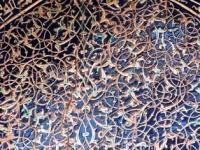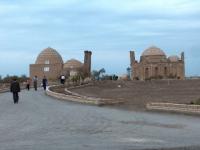You are here
Nadzhmetdin Kubra mausoleum.


Turkmenistan VIP tours.
"Overall, the monument presently lies in a state of general disrepair, although parts of it were repaired in 1950 after the collapse of the central dome. Large portions of the decoration on the pishtaq and on the sarcophagus of the saint are destroyed and are in need of comprehensive restoration work"
The Mausoleum of Shaykh Najm al-Din Kubra (1145 - 1221) is located in the ancient cemetery adjacent to the, modern city center of Kunya Urgench. Built by Qutlugh Timur (1321 - 1333), the governor of Khorezm, the mausoleum is named after Najm al-Din Kubra al Khorezmi, the Muslim philosopher who founded the Kubrawiyyah Sufi order.
Najm al-Din Kubra was also an artist, physician and a military general who was martyred during the Mongol invasion of Khorezm. Seven books and 24 Persian quatrains (rubai) written by Kubra survive to this day. He traveled widely and was also known as "Shaikh-i Wali Tarash", or the creator of saints.
The mausoleum oriented north to south consists of a large burial chamber (gurkhana) preceded by an entry vestibule flanked by two rooms (ziarat khana). All four spaces are covered with domes. A twelve meter tall projecting entry portal (pishtaq) leads into the vestibule from the north.
The twin-domed rooms while accessible from the entry vestibule also have their own entrances from the main north façade. Entering the burial chamber, the rectangular double sarcophagus of Najm al-Din Kubra is seen at the northwestern corner, with a smaller rectangular shrine beside it.
Kubra was beheaded defending Khorezm, which explains the double sarcophagus; one for his body and the other for his head. Historical photographs show that the sarcophagus was originally covered with blue glazed tiles and inscriptions, of which only the words "El Mulku-lillah" (All things are God's) are legible today.
Large arched niches carved into the walls animate the interior space. The transition to the dome is achieved with squinches. The interiors are lit with fours small screened windows on each dome in addition to a few small windows.
Outside, the surfaces of the brick domes are accentuated with bricks projecting out rhythmically every few courses. The octagonal drums seen inside the mausoleum are rounded on the outside. The exterior of the structure is largely plain exposed brick.
The decorative effort is concentrated on the pishtaq, which is decorated with blue glazed tiles with geometrical patterns, framed by a tile band of Arabic inscriptions painted in white on a blue background. These inscriptions praise Kutlugh Timur, the patron.
Two rows of muqarnas, mostly damaged, crown the pishtaq niche. The pishtaq itself is dangerously leaning northward. All the elaborately carved wooden doors in the monument are replicas, while the originals are kept inside with little or no protection.
Overall, the monument presently lies in a state of general disrepair, although parts of it were repaired in 1950 after the collapse of the central dome. Large portions of the decoration on the pishtaq and on the sarcophagus of the saint are destroyed and are in need of comprehensive restoration work.
Authority:
Bernshtam A.N. «History-archeologic sketches Central Tien-Shan and Pamir-Alay». « Religious and spiritual monuments of the Central Asia ». The author of M. Khashimov. Publishing house " Saga ", 2001.Tolstov S.P. « Ancient Khoresm », 1848. Tolstov S.P. « On traces Ancient Khorezm civilizations », М.-L., 1948. On materials of an information department of the State committee of Turkmenistan on tourism and sports.
Photos
Alexander Petrov.







